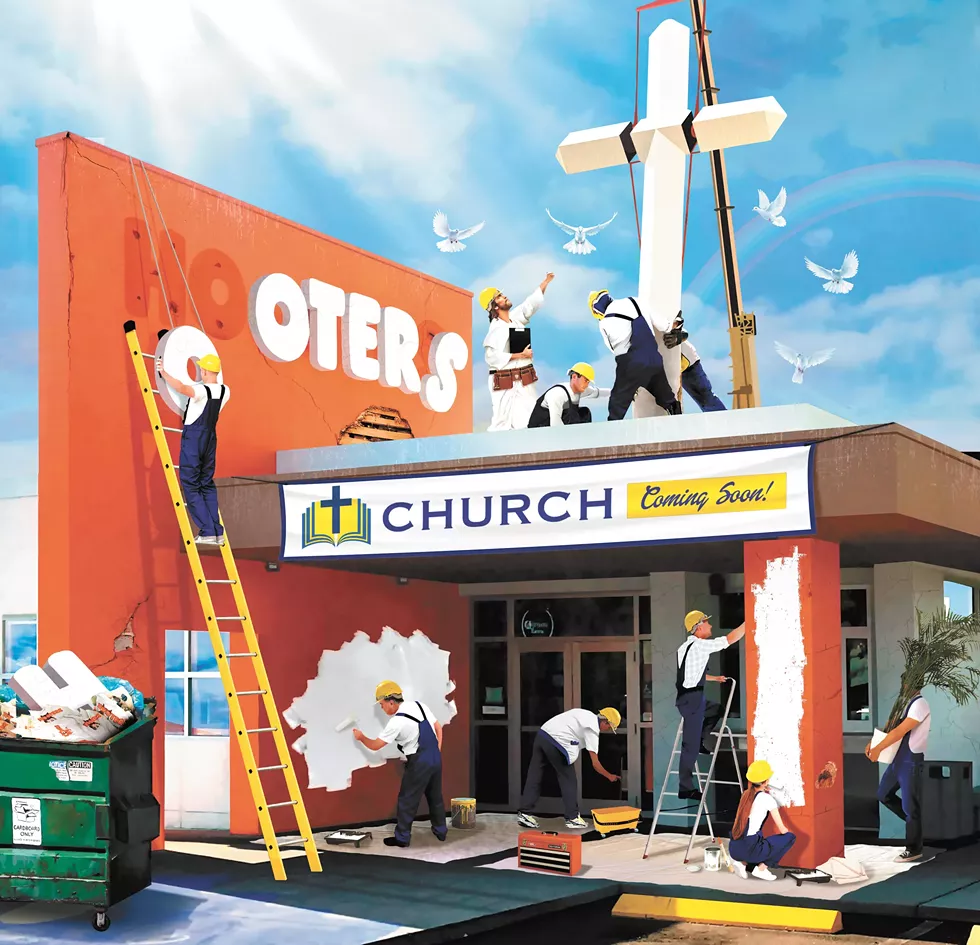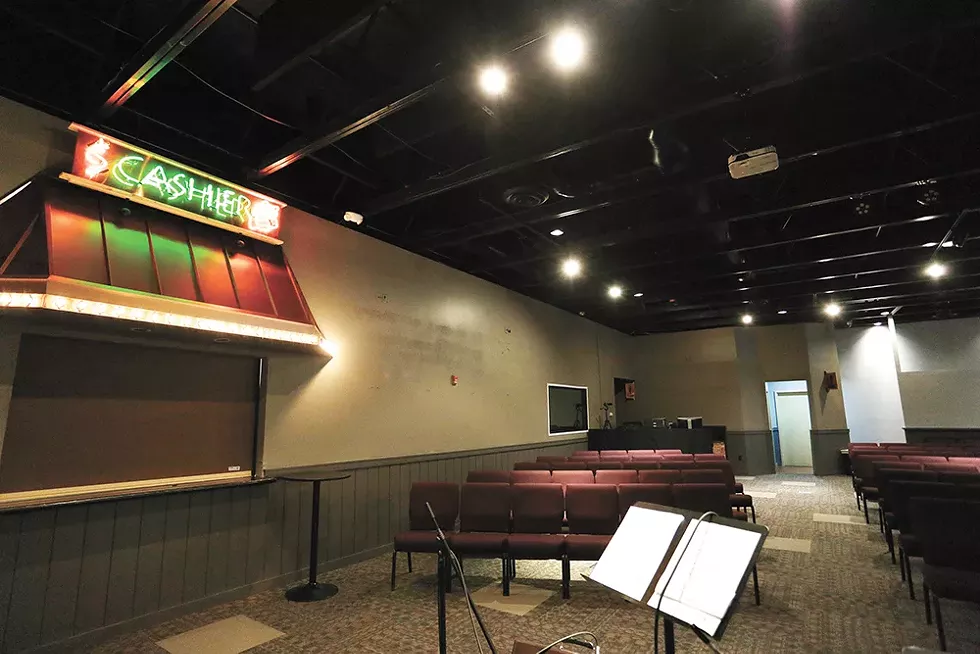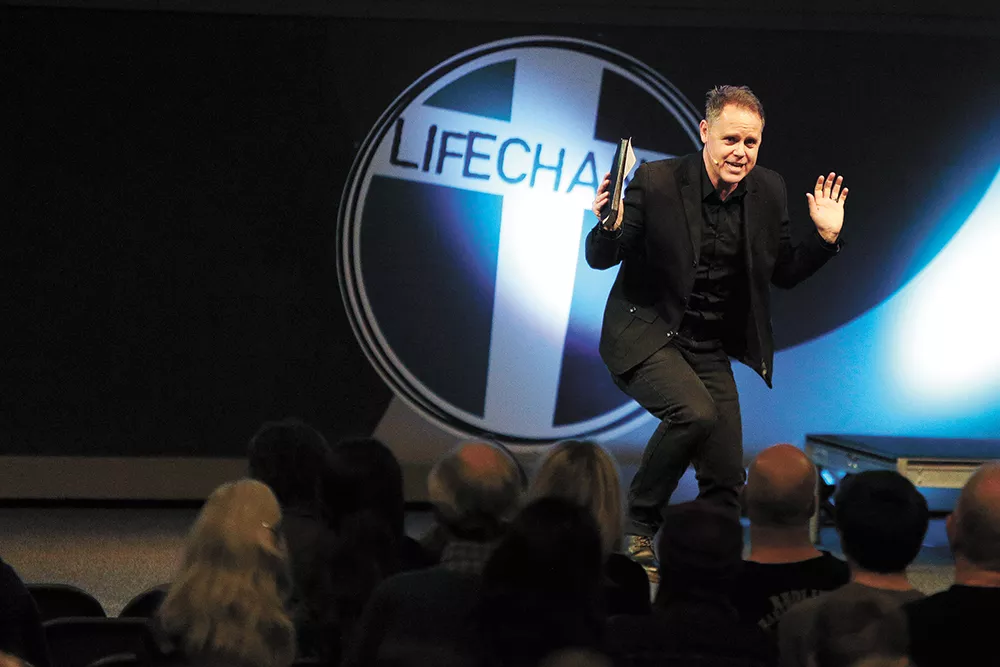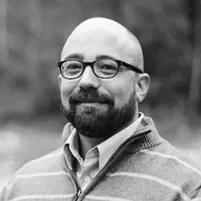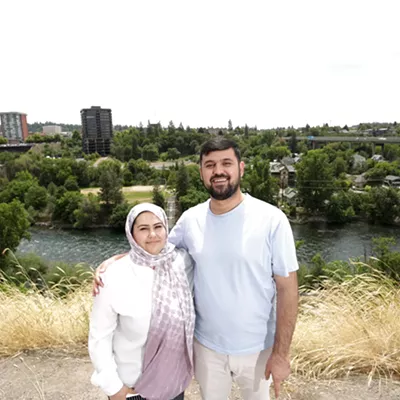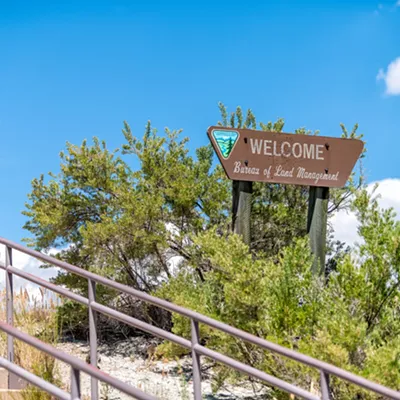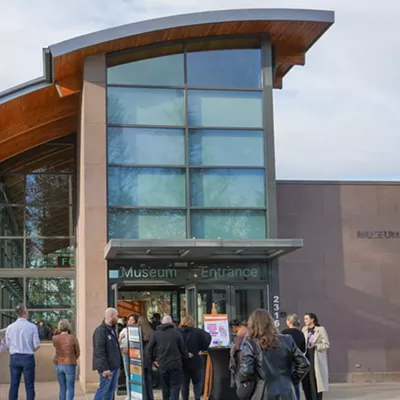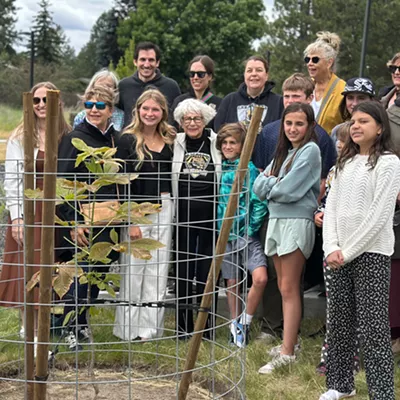Jesus walks into a Hooters bar...
It sounds like a good setup to a bad dad joke, but in reality, it goes something like this:
Jesus walks into a Hooters bar... and instead of finding boobs and hot wings, he discovers a joyous group of faithful followers — singing, dancing, clapping — led by a humble guitar-playing pastor who says God called him and his singer wife to convert an old Hooters bar and casino into a new home for their expanding flock.
Pastor Joe Pittenger has heard all the jokes. When your church is called Uplift and you take over what used to be part of the original "breastaurant" chain, you're going to need to have a sense of humor. Thank God, Joe does.
His favorite one-liner? "Uplift: The church that gives a hoot."
Let's clear up one thing: The name Uplift wasn't inspired by Hooters; it came to Pittenger at 3 am one morning as he suddenly woke thinking of John 12:32, "And I, when I am lifted up from the earth, will draw all people to myself." Uplift is the name that adorned Pittenger's church for five years when it was located in a warehouse in Liberty Lake and — despite the puerile wordplay it invites — it's the name he brought to the Spokane Valley Hooters' building last summer, with its huge sign soaring over Interstate 90.
"We're not going to take ourselves too seriously," says Pittenger, 52, chatting over coffee recently in what used to be the restaurant manager's office. "We take Jesus seriously."
In many ways, the location has been a godsend, he says: "We went from being hidden in Liberty Lake to 'Hello, here we are!'"
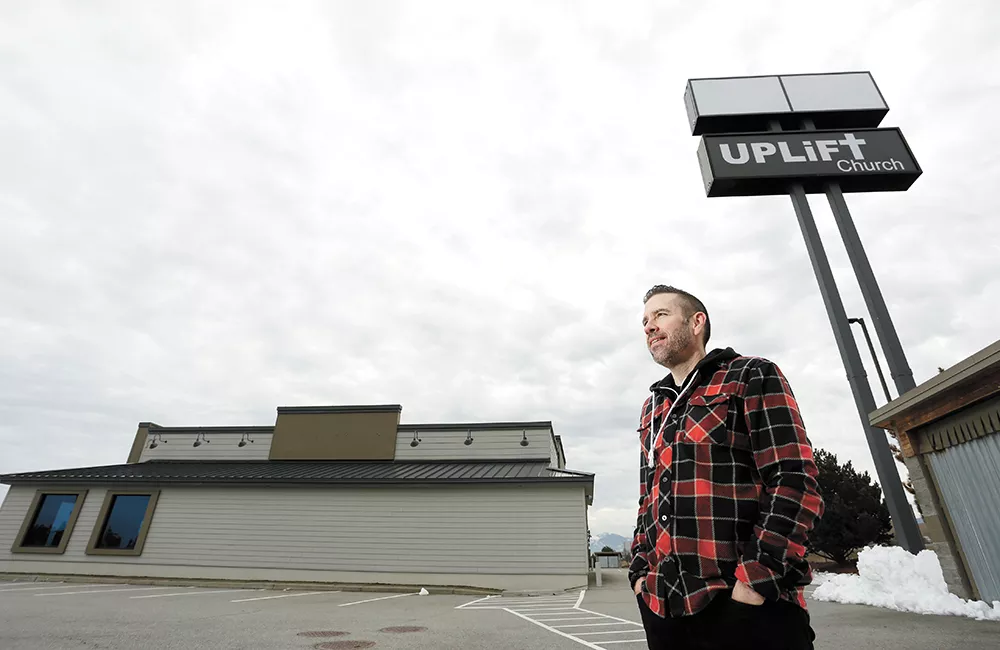
Churches like Uplift are popping up in surprising places all across America — in abandoned big-box stores, empty mega malls, strip malls, storefronts and, yes, in a failed Hooters next to the highway.
Nationwide, exact figures on these building conversions don't exist. But the phenomenon, driven in large part by contemporary evangelical Christian churches, is clearly visible well beyond the Bible Belt. Locally, you'll find churches in old movie theaters (Southside Christian Church in Spokane), hardware stores (The Cause in Coeur d'Alene) and supermarkets (Victory Faith in the Valley). And in one of the wilder examples in America, a long-dead shopping mall in Euclid, Ohio, was revived for a time by 24 churches that jointly came to call it home.
Not everyone celebrates this trend. When a church is able to take over what was once valuable and commercially productive property, it often signals that business activity is faltering. Among property owners, houses of worship have long been viewed as second-tier tenants because the foot traffic they draw is often limited to Sunday mornings. And while they tend to the spiritual needs of their congregations, churches — unlike retail businesses — don't pay property taxes or generate sales-tax revenue that state and local governments rely on.
But it's not a problem the churches themselves created. That story is much bigger, and there's plenty of finger pointing to go around. Blame the implosion of brick-and-mortar retail. Blame Amazon. Blame overbuilt mega malls rotting in neglected corners of suburbia. Or in the case of Hooters, do as some have suggested, and simply blame those pesky kids today: "Hooters had to close a bunch of locations because millennials don't like boobs very much," Maxim declared in 2017.
Not surprisingly, Pittenger — a flannel-wearing, mountain-bike-riding pastor — takes away a different message. Inside Uplift, he's left the old casino's cashier sign hanging in the church as a reminder: "I believe God can redeem anything."
CREATIVE DESTRUCTION
The apocalypse in commercial property can broadly be blamed on America's supersized portions: Simply put, we built way too much retail space.
"We as Americans are vastly over-retailed," explains June Williamson, a professor of urban design and architecture at the City College of New York, who co-authored the book Retrofitting Suburbia. In the United States, we have more than six times the square footage devoted to retail, per capita, than Europe — and 50 times, per capita, more than China.
This problem long predates Amazon. In hindsight, Williamson says, the second half of the 20th century was less about urbanization and more about suburbanization. Developers would scoop up cheap land, build malls and shopping districts and take advantage of tax breaks that incentivized new construction. Those properties would inevitably decline, and new developments would spring up, cannibalizing the market. Additionally, Williamson says, companies like Walmart would insist on non-compete clauses in their development projects so that if they were ever to close a location — say, to build an even bigger "supercenter" nearby — Target would be prohibited from moving into that vacant spot.
Add to that the emergence of online shopping, and — ta-da! — we have dying malls, empty big-box stores and companies like Sears filing for bankruptcy. But it's not all doom and gloom, Williamson says. In fact, her book is all about the creative ways Americans are "reinhabiting," "re-greening" and "redeveloping" these types of failing properties.
As Williamson and co-author Ellen Dunham-Jones write: "The big development project for the next 50 years likely will be retrofitting suburbia."
Churches aren't the only ones emerging to fill the gaps. Property owners are finding eager tenants in other business categories, including what Williamson calls "meds and eds." Indeed, the number of retail health clinics has exploded in America, growing by 445 percent between 2006 and 2014, according to one count.
The Lincoln Heights Shopping Center, anchored by Trader Joe's on Spokane's South Hill, is a good microcosm of what Williamson describes. On one side of the development, there's a retail clinic, Providence Express Care, right next to a tutoring business, Mathnasium. And on the other side? The Southside Christian Church now occupies about 33,000 square feet of what used to be a restaurant, a liquor store and a movie theater.
Lead Pastor Dave Long likes that the church is right in the center of the action. It fits his goal of being accessible: "We want to be a church where you don't have to learn a different language to understand it," he says, adding that he's proud that one word in particular stands bigger than the rest on the front of the building: "Jesus."
"It's almost a kind of user-friendly, easy way to slip back into church."
Southside Christian first leased the property in 2001, with an option to buy; the purchase terms were favorable — Long believes the owner didn't think they'd ever do it — and in 2006, the church bought the sprawling space for $2.25 million. It's since been transformed into administrative offices, classrooms, meeting space and a food bank, but the main sanctuary, where they hold Sunday services, remains as it was, with original theater seats and curtains from its days as Lincoln Heights Cinema.
"Don't touch the curtains — they're so old they might disintegrate," Long says with a laugh during a tour of the property. "The uglier and poorer a church is, the happier I am."
The church now claims about 1,000 members, and the building stays busy most days of the week with various programs and by loaning out the space to other community groups, he says. But being in a hub of activity has required that they also be vigilant about security, including stringing razor wire on the backside of the building to keep skateboarders off the roof.
It's a small price to pay to be caddy-corner to the heavily trafficked Trader Joe's — a company that shares food and flowers with the church, even though, as Long says, the two entities probably don't share the same values when it comes to the ballot box.
"Churches can be upper-class country club-ish," says Long, 44, wearing Doc Martens, blue jeans, a hoodie and sports coat. "We just take a lot of joy that there's a Goodwill across the street. We love the breadth of people that come to our church."
'NOT YOUR GRANDPARENTS' RELIGION'
Churches like Southside Christian and Uplift — that eschew steeples and dour architecture in favor of modern, nontraditional spaces — are part of a much larger cohort of evangelical Christians trying to make religion more accessible in America. No Latin or secret codewords required, these churches tend to have generically inspirational names (like Hope, Life or Grace) and are often led by handsome, charismatic pastors in blue jeans and untucked button downs. They have slick websites, active social media channels and a drum kit on stage.
In large part, they're nondenominational or independent Christian churches, and taken as a whole, they've become a growing force in the religious life of America, says Scott Thumma, director of the Hartford Institute for Religion Research, who prepared a expansive 2010 report on these types of congregations. By his count, these churches are second in number only to Southern Baptist ones, and third in adherents behind the Baptists and Catholics.
"It's almost a kind of user-friendly, easy way to slip back into church," Thumma says of these congregations. "They have more contemporary music, they use screens, often their buildings don't look anything like what one would think would be a church and they have names like Willow Brook. ... So it does lower the barrier."
Their success has led many mainline churches to rebrand themselves, dropping their denominational affiliation in name, or practice, or both, Thumma says. A 2017 report by Gallup noted that the number of Christians not identifying with a specific denomination doubled between 2000 and 2016. The report concluded that "Churches that adhere to specific and historical denominational affiliations appear to face the biggest challenge in American Protestantism today."
By dropping those labels, churches are able to shed any unflattering associations people may have with a particular denomination, and it forces people seeking a congregation to consider each church individually, without the aid of a shorthand identifier, Thumma says.
"They can't really anticipate what it's going to be because it doesn't have the label, which carries some sort of identity baggage, and so the only way they can really learn about it is going inside," Thumma says. "And once they go inside, they feel the community and excitement of worship."
That's certainly the hope of Aaron Richner, 36, lead pastor of The Cause, who prefers the term "worship experience" to "church service." He opened the doors to his nondenominational church about two months ago in what was formerly an Ace Hardware on Sherman Avenue in Coeur d'Alene. Like Pittenger from Uplift, Richner is a guitar player turned preacher, and the converted worship space reflects that, with a drum set, colorful stage lighting and musicians backing Richner's sermons.
"We get a lot of comments like, 'This is not what I pictured it to be. This is not what I thought church was,'" says Richner, wearing, as he often does on Sundays, a full beard, torn jeans and a black leather jacket. "One of our key phrases is: We like to make it loud. We mean that in the spiritual sense. We want to share the gospel, but also — literally — it's loud."
The aesthetic and approach of these churches is also common among today's biggest "mega churches," many of which are nondenominational themselves, says Thumma. In 2010, he conducted a national survey of mega churches — defined generally as Protestant congregations of 2,000 or more — and counted 1,600 across the country. He's planning an updated census in 2020, and he estimates there are now about 1,750. That figure is probably an undercount, he says, because the current trend among these churches is to plant multiple sites.
"The phenomenon is still growing," Thumma says, adding that traditional worship features (like organs and choirs) continue to decline among these huge congregations. "There was a negative impression of traditional religion, in those organ and steeple models, so they intentionally tried to design a religious community that didn't look like that. They wanted to clearly have a message that this was not your grandparents' religion."
Real Life Ministries, headquartered in Post Falls, is the largest church in the Inland Northwest and, according to its founder, the largest in the state of Idaho. More than 8,000 attend weekly services. That's just at the one location: Real Life has added three satellite campuses and helped to plant eight other churches in the Northwest and Texas, including the local Valley Real Life, which now draws more than 2,000 people a week.
"People think they know what church is. They don't," says founder and senior pastor Jim Putman, 52, a former wrestling coach. "We called it Real Life Ministries because if you were to do a word association game with non-Christians, and I were to say, 'What's the first thing that comes to your mind when you think of church,' it's usually not very good."
Real Life's sprawling Post Falls campus is surrounded by state-of-the-art sports fields and a new gym. Meanwhile, its main building, a massive 100,000-square-foot facility, serves as launch pad for everything from job training and child care to treatment for addiction to porn.
Putman says it wasn't his intention to build a mega church back in 1998, when they first started meeting on Sunday mornings in a local movie theater. But as he says, "healthy things reproduce." He attributes the shrinking influence of other churches, especially denominational ones, to them becoming "very liberal" and losing sight of their mission.
"When you start coming up with new doctrine about sexuality, when you start coming up with new doctrine about salvation, we were warned all throughout Scripture about fake news," he says. "Fake news is nothing new."
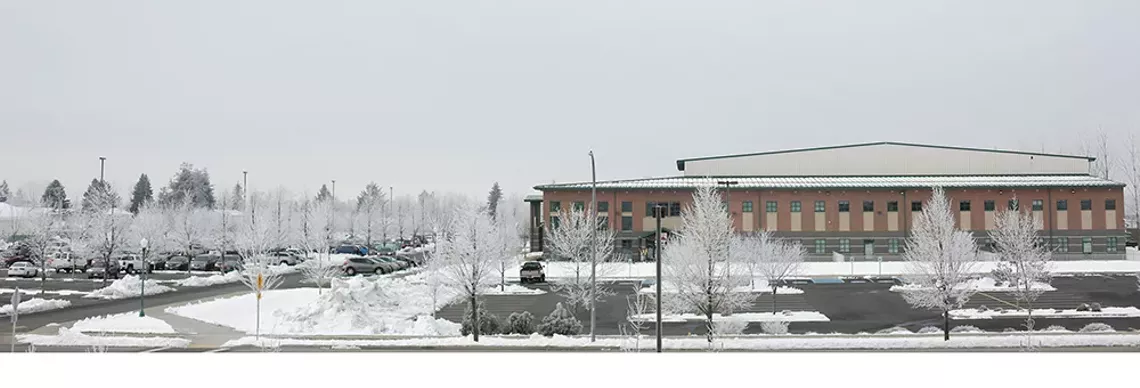
RISE OF THE 'NONES'
Here's a bit of real news about the nons versus the so-called "nones": While the nondenominational movement remains a powerful force reshaping Christianity, the bigger story in American religion today is the rise of people who claim no religious affiliation at all, Thumma says. These "nones" self-identify as atheists and agnostics or answer "nothing in particular" when asked about their religion.
"Increasingly it's not necessary to belong to a particular religion, whatever it is, and so when you ask someone now, they don't even give you, 'Oh yeah, well, my parents were Methodist so I guess I'm Methodist.' They just say, 'Well, I don't really affiliate with anything,'" Thumma says. "That loosening of the importance of having a religious label is pretty significant. That really reflects on a change that is taking place in all of society, in the entire culture."
Nones make up about 23 percent of the country, according to Pew Research Center's 2014 Religious Landscape Study, up from 16 percent in 2007. They tend to be younger — 35 percent of Millennials (born 1981-1996) are considered to be nones — but even Baby Boomers are increasingly moving in that direction, Pew found. Not all are atheists. Follow-up research by Pew found the most common explanation for being unaffiliated was the fact the nones questioned religious teachings. The second most common reason? They didn't like the social and political positions taken by churches. The majority of the nones lean politically Democratic and support LGBT and abortion rights.
Interestingly, though, while Americans overall are becoming less religious, Pew at the same time noted increases in feelings of spirituality. Perhaps, then, these are people who might be open to more contemporary churches that look and feel different, that are located next to their favorite Trader Joe's or in the old Hooters they used to frequent.
"I'm not sure that they do it out of a marketing strategy," Thumma says of nondenominational churches, "but it is an adaptation that seems to work well in the current culture and climate."
For his part, Uplift's Pittenger says the goal in planting a new church is not to steal members from other congregations, but rather to reach "unchurched" people who've never been to one. In that regard, he says, it doesn't hurt that a building had a previous life, even a colorful one.
"People, they don't feel threatened here," he says.
In fact, he's had several worshippers attend Sunday services, only to tell him some version of the same story: "I used to play slots right here, drinking," Pittenger recalls, adding, "You are welcomed here as you are."
In comparison to many of the bigger congregations in the area, Pittenger's "no thrills community church all about Jesus" remains a relatively modest space — with 200 donated chairs, a small stage with a drum set, two classrooms and an area for nursing mothers. But don't forget the spacious walk-in refrigerator built to store kegs.
Standing in what used to be the bar, which he hopes to eventually convert into a kitchen, Pittenger boasts of his beer fridge: "Not many churches have one of those!" ♦
RELIGION MEETS POLITICS
The rise of nondenominational churches is driven in large part by evangelical Christians, who tend to strongly lean Republican, oppose gay marriage and believe humans always existed in their current form (rather than having evolved), according to studies by the Pew Research Center. Their politics generally put them at odds with the so-called "nones," those people unaffiliated with any particular religion. However, their approach to worship — contemporary and accessible — may be appealing to those who have negative associations with more traditional churches, says Scott Thumma, director of the Hartford Institute for Religion Research.
CHURCH-OWNED PROPERTY
In Spokane County, churches own more than 400 tax-exempt properties valued at more than $503 million, records show. In Kootenai County, religious organizations own another 200 properties worth an estimated $260 million. The most valuable piece of tax-exempt property between the two counties is the Salvation Army's Kroc Center, assessed at $29 million.
WASHINGTON AND IDAHO
Churches are automatically tax-exempt and don't have to register with the IRS or, generally, with the state in which they reside. Still, many opt to incorporate as 501(c)(3) nonprofits. Washington state records don't differentiate between churches and other nonprofit organizations, but a search of nonprofits with "church" in their name yields 3,523 active groups. The same search in Idaho yields 1,545.
ABOUT THE AUTHOR
Jacob H. Fries is the editor of the Inlander. Growing up in Spokane Valley, his mom was Jewish, his dad a non-practicing Catholic, and at home they celebrated Christmas and Easter. Before joining the Inlander in 2008, he was a staff writer at Florida's biggest newspaper, the St. Petersburg Times (now the Tampa Bay Times), and around 2004, he had happened to visit the original Hooters location in Clearwater, Florida. Even then, he found the restaurant chain to be out of date and tacky. Send comments to editor@inlander.com.

